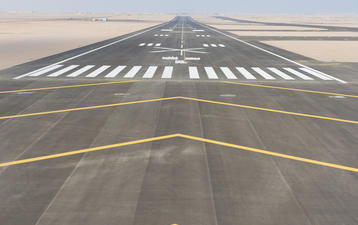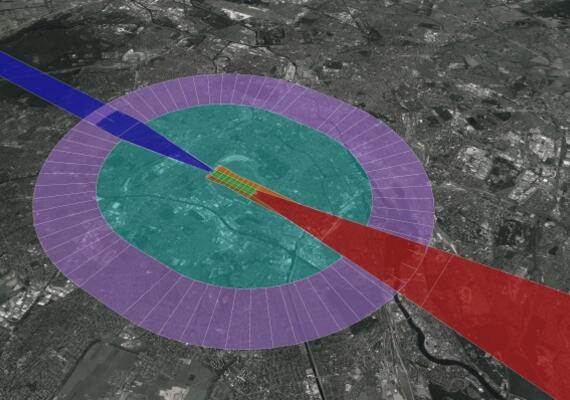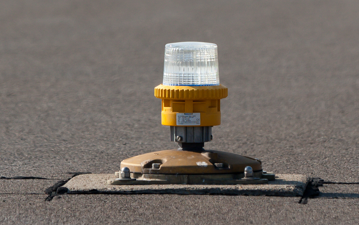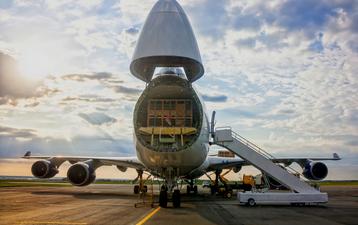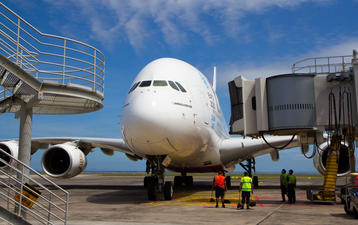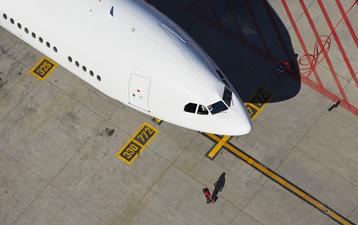Runway, Taxiway, Apron Planning and Design (ICAO Annex 14)
The International Civil Aviation Organisation (ICAO) Annex 14 to the 1944 Chicago Convention contains the Standards and Recommended Practices (SARPs) that prescribe the physical and operational characteristics to be provided for at aerodromes.
ICAO Annex 14 is the basis of most national regulations, including CASR Part 139 in Australia, CARs Part IX in the UAE, CAR Part 139 in New Zealand, TP 312 in Canada, Manual of Aerodrome Standards in Singapore, as well as many other implementations (EASA, FAA etc.).
This 4-day course enables the participants to interpret and implement the ICAO Annex 14 specifications – or the national implementation thereof – related to Runways, Taxiways, Aprons and adjacent areas.
The course content is based on the international ICAO requirements – but is also customised to its audience, location and applicable regulatory framework, notably to highlight the major differences between international regulations and their national implementation.
Based on best practices, the participants will become knowledgeable about the configuration, dimensioning and design of these fundamental infrastructural elements and will learn how to fulfil planning and design requirements. Furthermore, special attention is set on the theoretical and practical background of the above-mentioned regulations, and on the implementation of possible mitigation measures in case of non-compliance with the requirements.
This course targets all staff involved in aerodrome design, operations and compliance. This include airport planners and engineers, aerodrome compliance managers, auditors, accountable managers, military airfields officers, and of course Civil Aviation Authorities and regulatory oversight personnel.
Please note: This course can be booked as an in-house version in German or English - however, the course material is only available in English.
Course Details
Location:SingaporeLanguage:English
Date:06.05. - 09.05.2025
Duration:4 days
Provider:airsight Singapore Pte. Ltd.
Course Fee
No taxes will be added to the invoice for courses in Singapore.
Please note: This course is run by airsight Singapore Pte. Ltd. Terms & Conditions of airsight Singapore Pte. Ltd. apply.
Course Content
General Planning Principles and Fundamentals
- Overview of international (ICAO) and national (based on course location, see list below) regulations for airport planning and design
- Governing legally binding principles
- Overview of additional guidance material (e.g. ICAO manuals, IATA/ACI guidance material)
- Definition of the most critical aircraft
- Relevant aircraft performance parameters (e.g. speed and weight limitations)
Runway Planning and Design
- Dimensioning, configuration and design of runways
- Identification of the objectives and constraints depending on the airport critical aircraft (e.g. for the determination of takeoff- and landing distances)
- Markings (e.g. centre line, side stripe, touchdown zone)
- Signs (e.g. information- and mandatory instruction signs)
- Lights (e.g. centre line lights, approach lighting systems)
- Runway shoulders and strips
- Runway holding positions
- Obstacle limitation requirements
- Handling of non-compliances (mitigation measures, safety assessments)
Taxiway and Apron Planning and Design
- Design, dimensioning and configuration of manoeuvring areas and aprons
- Identification of the objectives and constraints depending on the aircraft and traffic mix
- Discussion of different manoeuvring area- and apron concepts
- Calculation of aircraft turning curves (Fillet Design)
- Taxi guidance components (intermediate holding positions, stop bars and leading on lights)
- Taxiways, rapid exit taxiways, holding bays and bypasses
- Aircraft stands, aircraft stand taxi lanes, apron taxiways, aerodrome service roads
- Taxiway shoulders and strips
- Markings (e.g. for taxi guidance, holding positions)
- Signs and markers (e.g. information signs, destination and mandatory instructions signs, taxiway edge markers)
- Lights (e.g. taxiway lighting)
- Handling of non-compliances (mitigation measures, safety assessments)
- Operation and constrains regarding operation of New Larger Aeroplanes (NLA)
Note: Based on the course audience and location, the course content may incorporate elements and differences of the following national regulations:
- Civil Aviation Authority of Singapore (CAAS): Manual of Aerodrome Standards
- Australia Civil Aviation Safety Authority (CASA): Civil Aviation Safety Regulations (CASR) Part 139 - Aerodromes
- Civil Aviation Authority (CAA) of New Zealand: Civil Aviation Rules Part 139 - Aerodromes
- United Arab Emirates (UAE) General Civil Aviation Authority (GCAA): Civil Aviation Regulations (CARs) Part IX - Aerodrome
- Transport Canada: Aerodromes Standards and Recommended Practices (TP 312)
Trainer
Dipl.-Ing. Jan Friedrich
Jan is airsight’s Regional Manager for the Asia-Pacific region.
He holds a Diploma degree in Aeronautics and Astronautics and has more than 15 years’ experience as a senior aviation consultant. Jan was involved in worldwide projects in the field of e.g. aerodrome planning, safety/risk assessments and audits. He has also shared his extensive knowledge as a renowned trainer with other international experts from all over the world.
Additionally, for 5 years, Jan was the nominated EASA Compliance Manager / Head of EASA Compliance & Change Management at an international airport in Germany.
In both roles he gained extensive knowledge in international aerodrome regulations and their application (e.g. ICAO, EASA), management of changes and dealing with non-compliances. This covers aerodrome’s infrastructure, organization and operations with regards to compliance and safety.
Furthermore, Jan is a representative and an expert in national/international panels as well as in expert groups (ADV, ACI, EASA).
Target Group
- Airport operations managers
- Airport engineers and planners
- CAA aerodrome inspectors
- Aerodrome auditors
- Architects and civil engineers
Course Location
Participants are responsible for making their own travel arrangements. The accommodation and travel costs are at the charge of the participants. Please note that airsight does not perform any travel and hotel bookings for the participants.
The course fee includes the registration, training material and examination. Coffee breaks and business lunch are also included.
Organisational Details
The course hours are scheduled as follows:
09:00 am - 5:00 pm (SGT)
At the end of the course, all participants will receive an airsight certificate based on ICAO/EASA training regulations, which is highly recognised throughout the aviation industry.
About airsight Training
airsight Training course quality
airsight operates an ISO 9001 certified Quality Management System and pursues the objective to provide high quality services that fully meet the clients’ needs.
Course Details
Location:BerlinLanguage:English
Date:13.10. - 16.10.2025
Duration:4 days
Provider:airsight GmbH
Course Fee
For courses in Berlin:
All customers will be charged 19% VAT.
The final price will be shown on your invoice.
Please note: If you want to register several particpants from your company but need a single invoice for each, please register each of them seperately.
Course Content
General Planning Principles and Fundamentals
- Overview of international (ICAO) and national (based on course location, see list below) regulations for airport planning and design
- Governing legally binding principles
- Overview of additional guidance material (e.g. ICAO manuals, IATA/ACI guidance material)
- Definition of the most critical aircraft
- Relevant aircraft performance parameters (e.g. speed and weight limitations)
Runway Planning and Design
- Dimensioning, configuration and design of runways
- Identification of the objectives and constraints depending on the airport critical aircraft (e.g. for the determination of takeoff- and landing distances)
- Markings (e.g. centre line, side stripe, touchdown zone)
- Signs (e.g. information- and mandatory instruction signs)
- Lights (e.g. centre line lights, approach lighting systems)
- Runway shoulders and strips
- Runway holding positions
- Obstacle limitation requirements
- Handling of non-compliances (mitigation measures, safety assessments)
Taxiway and Apron Planning and Design
- Design, dimensioning and configuration of manoeuvring areas and aprons
- Identification of the objectives and constraints depending on the aircraft and traffic mix
- Discussion of different manoeuvring area- and apron concepts
- Calculation of aircraft turning curves (Fillet Design)
- Taxi guidance components (intermediate holding positions, stop bars and leading on lights)
- Taxiways, rapid exit taxiways, holding bays and bypasses
- Aircraft stands, aircraft stand taxi lanes, apron taxiways, aerodrome service roads
- Taxiway shoulders and strips
- Markings (e.g. for taxi guidance, holding positions)
- Signs and markers (e.g. information signs, destination and mandatory instructions signs, taxiway edge markers)
- Lights (e.g. taxiway lighting)
- Handling of non-compliances (mitigation measures, safety assessments)
- Operation and constrains regarding operation of New Larger Aeroplanes (NLA)
Note: Based on the course audience and location, the course content may incorporate elements and differences of the following national regulations:
- Civil Aviation Authority of Singapore (CAAS): Manual of Aerodrome Standards
- Australia Civil Aviation Safety Authority (CASA): Civil Aviation Safety Regulations (CASR) Part 139 - Aerodromes
- Civil Aviation Authority (CAA) of New Zealand: Civil Aviation Rules Part 139 - Aerodromes
- United Arab Emirates (UAE) General Civil Aviation Authority (GCAA): Civil Aviation Regulations (CARs) Part IX - Aerodrome
- Transport Canada: Aerodromes Standards and Recommended Practices (TP 312)
Trainer
Denis Thiemer, Dipl.-Ing.
Denis holds a diploma in Transport Engineering and is further specialised in aerodrome design and operations with wide ranging experience in airside infrastructure design and aerodrome safety as well as compliance with ICAO SARPs and European aerodrome regulations.
With his expert knowledge and expertise, he has been supporting numerous airports worldwide in planning tasks within airside expansion and redesign projects, compliance assessments and aeronautical studies. Also, he assists clients in developing innovative operational concepts for safe and efficient airside operations. Another one of his fields of activity is Advanced Air Mobility and the operation of eVTOL aircraft, where he has been involved in vertiport feasibility studies, conceptual design tasks and associated approval processes. Furthermore, he is an instructor for a variety of airsight’s training courses.
Denis realized projects with aerodrome operators in Germany and abroad (e.g. Australia, Belgium, Cameroon, Jamaica, Luxembourg and New Zealand). Most recently he led a major aircraft stand redesign project with Frankfurt Airport aiming for compliance with EASA Certification Specifications for Aerodrome Design.
Target Group
- Airport operations managers
- Airport engineers and planners
- CAA aerodrome inspectors
- Aerodrome auditors
- Architects and civil engineers
Course Location
Participants are responsible for making their own travel arrangements. The accommodation and travel costs are at the charge of the participants. Please note that airsight does not perform any travel and hotel bookings for the participants. Rooms can however be booked directly by the participants by contacting the hotel.
The course fee includes the registration, training material and examination. For non-virtual courses, coffee breaks and business lunch are also included.
Organisational Details
The course hours are scheduled as follows:
first training day: 10:00 am - 5:00 pm
mid-training days: 9:00 am - 5:00 pm
last training day: 8:00 am - 4:00 pm
Coffee breaks and business lunch are included in the course fee. At the end of the course, all participants will receive an airsight certificate based on EASA training regulations, which is highly recognised throughout the aviation industry.
About airsight Training
airsight Training course quality
airsight operates an ISO 9001 certified Quality Management System and pursues the objective to provide high quality services that fully meet the clients’ needs.
Course Details
Location:In-houseLanguage:German / English
Date:(on-site or virtual)
Duration:4 days
Provider:airsight GmbH
Course Content
General Planning Principles and Fundamentals
- Overview of international (ICAO) and national (based on course location, see list below) regulations for airport planning and design
- Governing legally binding principles
- Overview of additional guidance material (e.g. ICAO manuals, IATA/ACI guidance material)
- Definition of the most critical aircraft
- Relevant aircraft performance parameters (e.g. speed and weight limitations)
Runway Planning and Design
- Dimensioning, configuration and design of runways
- Identification of the objectives and constraints depending on the airport critical aircraft (e.g. for the determination of takeoff- and landing distances)
- Markings (e.g. centre line, side stripe, touchdown zone)
- Signs (e.g. information- and mandatory instruction signs)
- Lights (e.g. centre line lights, approach lighting systems)
- Runway shoulders and strips
- Runway holding positions
- Obstacle limitation requirements
- Handling of non-compliances (mitigation measures, safety assessments)
Taxiway and Apron Planning and Design
- Design, dimensioning and configuration of manoeuvring areas and aprons
- Identification of the objectives and constraints depending on the aircraft and traffic mix
- Discussion of different manoeuvring area- and apron concepts
- Calculation of aircraft turning curves (Fillet Design)
- Taxi guidance components (intermediate holding positions, stop bars and leading on lights)
- Taxiways, rapid exit taxiways, holding bays and bypasses
- Aircraft stands, aircraft stand taxi lanes, apron taxiways, aerodrome service roads
- Taxiway shoulders and strips
- Markings (e.g. for taxi guidance, holding positions)
- Signs and markers (e.g. information signs, destination and mandatory instructions signs, taxiway edge markers)
- Lights (e.g. taxiway lighting)
- Handling of non-compliances (mitigation measures, safety assessments)
- Operation and constrains regarding operation of New Larger Aeroplanes (NLA)
Note: Based on the course audience and location, the course content may incorporate elements and differences of the following national regulations:
- Civil Aviation Authority of Singapore (CAAS): Manual of Aerodrome Standards
- Australia Civil Aviation Safety Authority (CASA): Civil Aviation Safety Regulations (CASR) Part 139 - Aerodromes
- Civil Aviation Authority (CAA) of New Zealand: Civil Aviation Rules Part 139 - Aerodromes
- United Arab Emirates (UAE) General Civil Aviation Authority (GCAA): Civil Aviation Regulations (CARs) Part IX - Aerodrome
- Transport Canada: Aerodromes Standards and Recommended Practices (TP 312)
Trainer
Dirk Anders
Dirk is an experienced airport planner, providing on behalf of airsight since more than 10 years his expertise in the field of runway, taxiway and apron planning and design to international clients. He is notably a renowned expert in the field of gate design and aircraft stand layout optimisation and a proficient user of CAD-based applications (AutoCAD / MicroStation / Aviplan).
Dirk is very knowledgeable in the international aerodrome regulations (ICAO/EASA), their national implementation, as well as industry’s best-practices. He gathered extensive experience in more than 100 projects for clients including Dubai, Brussels or Auckland Airports – as well as most airports in Germany.
More recently, he provided his support during several weeks on-site to Hannover Airport to assess the compliance of the airside infrastructure with EASA aerodrome regulations.
Another field of Dirk's expertise is aerodrome safeguarding and the management of obstacles, as well as flight procedure design according to PANS-OPS.
Moritz Kaschel, M.Sc.
Moritz holds a Master’s Degree in Aeronautical Engineering and is further specialised in Airport Management Systems, Auditing and Aerodrome Planning. As a member of airsight’s consulting team, these combined competencies enable him to assist Aerodromes within their certification process and related fields (e.g. compliance checks and inspections, manuals and procedures, ground handling processes).
At airsight, he conducted several projects for airports such as Dublin, Milan, Luxembourg and others. He also conducted inspections of their airside infrastructure (incl. signs, lights, marking), including the assessment of the pavement conditions - using drones (as holding a commercial UAV operator license and radiotelephone operator´s certificate).
More recently, Moritz assisted Luxembourg Airport to obtain a new certificate in accordance to the new EASA requirements – a task of several months requiring a good knowledge of the applicable regulations as well as project management skills. Additionally, he was involved in the development of a corrective action plan for a major Middle Eastern airport and conducted airside infrastructure inspections in western Africa.
With his broad ranging experience regarding Airport Management Systems and Compliance, he is an instructor for multiple airsight courses.
Target Group
- Airport operations managers
- Airport engineers and planners
- CAA aerodrome inspectors
- Aerodrome auditors
- Architects and civil engineers
Organisational Details
airsight offers this training course on request, worldwide. At the end of the course, all participants will receive an airsight certificate based on EASA training regulations, which is highly recognised throughout the aviation industry.
About airsight Training
airsight Training course quality
airsight operates an ISO 9001 certified Quality Management System and pursues the objective to provide high quality services that fully meet the clients’ needs.

